INTRO:
Luck has always been a significant factor in the strategy sub-genre of turn-based tactical games. There are plenty of excuses to justify this: that luck is somehow the great equalizer that levels the playing field between players of different skill levels, that it somehow injects variety into the gameplay experience, or that it is somehow an inherent source of gameplay balance.
All of these do not address the issue that luck makes for fickle gameplay. So it is that even the most sophisticated of such games, with layers of depth and complexity, could still give infuriatingly sour experiences when plans go awry because of an RNG roll gone astray.
That was so, until Into the Breach showed how luck as a factor can be pared back in game design and still result in a very good game.
PREMISE:
Before describing the gameplay, the story of the game – partially written by none other than Chris Avellone – would have to be described first, because some of its elements are used as the justification for the presence of some gameplay designs.
In the far future, humanity is very much screwed. Rising sea levels and the emergence of giant primordial creatures bring with them the threat of extinction. The latter, in particular, have destroyed much of humanity, reducing civilization to a few inhabited islands. They are called the Vek, and they are relentless as they are numberless.
Then, there are those who wish to prevent the extinction of humanity, by whatever means necessary – even if the means would doom them to endless sanity-eroding time-travelling. Oh, and they use gigantic war machines, simply called Mechs.
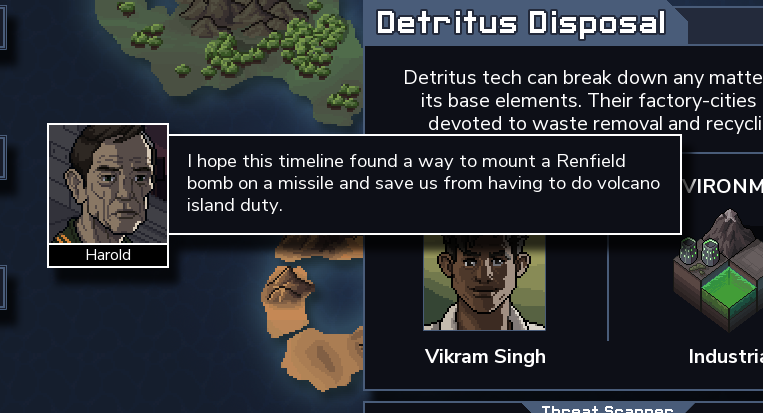
8 X 8 BATTLEFIELDS:
The game takes place on islands, seemingly small ones too. This is used as the justification for having small battlefields that seem initially laughably small.
Considering the movement speed of any unit, even the slowest, the battlefields can be crossed in just at most three turns. If the player is looking for a game where long-range running engagements are the battles that are fought, he/she would be sorely disappointed.
On the other hand, there is surprisingly a lot of things that can happen in such small battlefields, especially because units can be shifted around and/or redirected.
SHIFTING AND REDIRECTING UNITS:
The main conceit of the gameplay in Into The Breach is shuffling units around. That includes moving the player’s units, and the enemy’s, about.
Moving the former is par for the course in almost every tactical turn-based game, but the latter is something that is rarely if not never done. Games that did this before Into The Breach are often decried for having little gameplay balancing for such abilities that shuffle units on the opposing side. The most that the other games could do without upsetting gameplay balance is swapping places between units, but pushing enemy units off their previously occupied locations is something else.
This is not an issue in Into The Breach, mainly because the Vek are numberless. If the player does not deal with any existing Vek permanently after having pushed them around, he/she would eventually be overwhelmed by more and more Vek. Indeed, the player will have to find ways to kill the Vek like he/she would topple a row of dominoes.
MECHS:
For better or worse, “Mechs” in this game are considered to be anything that happens to be a giant war machine. The bipedal war machines that are unofficially considered to be the representation of “Mechs” by followers of science fiction are categorized as “Prime”-class in this game, likely as a reference to a certain Hasbro-owned character.
There are other war machines that are also called “Mechs”; some happen to have more than two legs, some happen to have giant treads instead of legs, some have no legs or treads because they hover or fly. These other classes are named according to their general roles: “Artillery”, “Brute”, “Jet”, “Science” and such other names that the game’s writers could think of.

In practice, these class names determine what kinds of gear can be mounted on them, and more often than not define their role in battle. For example, Science-class Mechs often have things that de-buff enemies, or buff the other Mechs.
PILOTS:
Every Mech comes with a pilot. One of the pilots will always be determined by the player; this pilot would either be selected from the roster of unlocked characters, or retained from the previous run through a fluke of time-travelling. (In the latter case, only one of the pilots can be retained, even if the player has managed to keep all pilots alive.)
In practice, pilots are the organic components of Mechs; they provide their bonuses to the Mechs as long as they are alive, but they have no control of their Mechs because that is the player’s prerogative. They also do not have any gameplay-affecting backstories or personal quests.
As the Mechs score kills, their pilots gain experience points. With enough experience points, they unlock the next tier of bonuses that they can provide to their Mechs. However, like the crewmembers in Faster Than Light, the pilots only have a couple of experience levels to achieve.
MECHS CAN BE RESTORED…:
No matter how well or poorly the player performed, the player will always enter battle with three Mechs. Even if the player did poorly in the previous battle and lost a Mech or two, the Mechs are always restored to full function – albeit that they might be missing their pilots.
… BUT PILOTS DIE:
Being the organic components of the Mechs also mean that they are the squishiest. Although the Mech would protect their pilots as long as they are functional, when they go down, their pilots often just die. As to be expected in a rogue-lite game, the pilot is permanently dead. (The player might find another time-copy of the same pilot in a time-pod; more on these later.)
There is a piece of gear that ensures that a pilot survives when his/her Mech is wrecked, but this comes with the opportunity cost of not fitting an actual weapon instead of said gear.
Mechs without pilots are “piloted” by on-board AI’s, which confer no bonuses whatsoever. Therefore, it is in the player’s interest to keep pilots alive as long as possible.
REACTOR CORES:
The Mechs have the minimum power that is necessary to run their default weapons and basic functions, but they need more power sources in order to further unlock their potential.
Reactor cores fulfil these needs. They are given as rewards for completing particularly troublesome objectives, as salvage from time pods (more on these later) or from purchasing them upon the completion of an island.
Reactor cores can be removed after installation, which is convenient, especially if the player intends to switch the equipment of a Mech.

PILOT ABILITIES – GENERIC AND UNIQUE:
As mentioned earlier, the pilots grant bonuses to the Mechs that they occupy. In the case of the generic pilots (who have portraits that are practically palette swaps of each other), the bonuses that they give are generally useful but uninteresting.
The unique pilots are more interesting, because one of their bonuses is unique. This unique bonus is always available and generally either remove a limitation or give an additional benefit to a certain action. The exception to this is the first unique pilot, whose ability is to increase the experience gain of all pilots.
SOME PILOT ABILITIES REQUIRING REACTOR CORES:
Some pilot abilities require the installation of reactor cores before they become active. Incidentally, all of the characters that have such abilities happen to be cyborgs, robots or androids (it is not clear which they are); presumably, they install the reactor cores in themselves.
Anyway, these abilities are incredibly useful. For example, one of these pilots turns any non-flying Mech into a flying one. Understandably, they are potent enough to mandate balancing in the form of core requirements.
GENERAL MOVEMENT:
Every unit, Mech or Vek, has a movement rating that determines how far they can move in their own turn. Their movement paths are always along the cardinal directions, and never diagonal. The game will automatically calculate the shortest valid path between the destination and the Mech/Vek, and decide whether the Mech/Vek can move there.
Interestingly, the path that the unit takes does not consider the hazards that it would pass through, nor would the hazards affect the unit. For example, even if a unit moved through a pool of A.C.I.D., it would not be soaked in it.
GROUND-BOUND UNITS:
Most Mechs and Veks are limited to movement along the ground. This means that they can be affected by terrain falling into the abyss or being pushed off cliffs and such. However, ground-bound units tend to have more hitpoints than flying ones.
FLYING UNITS:
Flying units are not affected by chasms, holes or other hazards that would affect ground-bound units. However, they can still be affected by terrain-based de-buffs. For example, if a flying unit moves over a pool of A.C.I.D., it will be doused with the chemical anyway, even if it looks like it has not immersed itself in the pool at all.
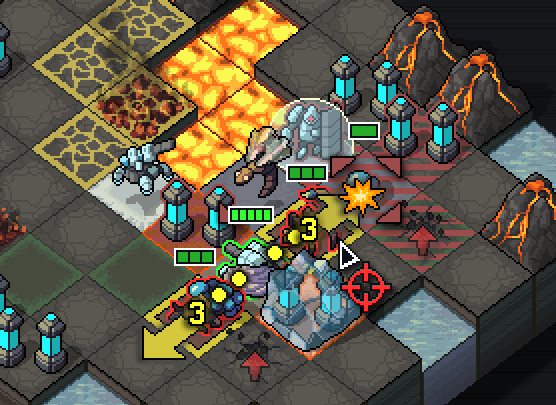
MECH STATS:
Any Mech of any class can have the same types of equipment, if the player can come across these during a playthrough. For example, the Charger Mech may start with equipment that lets it ram enemies, but any other Brute Mech can ram enemies too if the same equipment is installed into it. (The artwork for the equipment may depict the Mech that is associated with it, but this is just cosmetic.)
However, they are differentiated from each other through their basic stats, which are typically their hitpoint counts and move points; every Mech has its own maximum potential hit point and move point counts. This information is not immediately shown to the player, however.
There may be other differences, such as the aforementioned flying/non-flying capabilities. Some Mechs also have permanent Armored buffs, which reduce damage from incoming attacks by one point.
DE-BUFFS:
Speaking of de-buffs, there are a few that can affect either Mechs or Veks. The first of these is the aforementioned A.C.I.D. Despite the acronym, it does not cause damage over time; instead, it doubles the amount of damage that an affected unit takes from an attack that lands.
Fire causes damage over time. This can be inflicted on a unit when it ends its turn in a tile that is on fire, or when it is hit by an attack that sets things on fire. Fire does not go out on its own; it has to be extinguished by immersing the unit in water, inflicting the frozen de-buff on it, or repairing a Mech. Incidentally, most of these means are only available the Mechs, so fire is a very effective weapon against the Vek.
SHIELDS & FROZEN STATES:
There are not a lot of buffs or simultaneous buff/de-buffs in this game, but whatever there are contribute greatly to the gameplay, surprisingly enough.
The first of these is the Shield. It only absorbs one application of damage from any source before going down, but it can take any hit of any strength. More importantly, the shield also prevents the application of the fire and frozen states, which can be incredibly useful in some situations, e.g. it mitigates the drawback of a certain weapon that inflicts the frozen state on enemies.
Next, there is the Frozen state. It prevents an afflicted unit from doing just about anything. In fact, any enemy that is trapped in ice is considered as being out of action. However, they can be released by simply hitting them; the ice is shattered, but they are completely unharmed. This can be used in the player’s favour, such as freezing a Mech that has to block an incoming attack from hitting a building.
REPAIRING:
In lieu of doing anything else, a Mech can spend its turn to repair itself. This restores one of its lost hitpoints, while also removing fire and A.C.I.D. de-buffs, or breaking out of ice.
NO BUFF/DE-BUFF STACKING:
Any unit can only be affected by one buff or de-buff at a time. (This is also the reason for the Shield being able to prevent the infliction of fire and frozen de-buffs.) The Vek could have been easier to deal with if the player could stack de-buffs, but unfortunately, this is not possible.
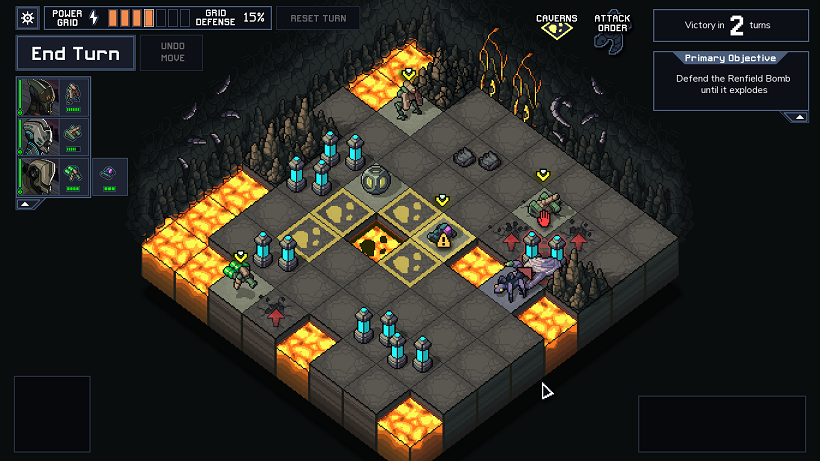
MECH SQUADS:
One of the main conceits of the gameplay is that the player must choose a squad of Mechs to bring into a playthrough; the Mechs cannot be swapped out for others afterwards.
Each Mech squad starts with a load-out that favours a specific strategy. For example, the Judoka Squad has a load-out that is oriented around shifting Vek here and there so that they can be knocked down in tandem.
Of course, after the player has obtained more equipment, the Mech squad’s playstyle can change significantly depending on the player’s choices in kitting them out.
Not all Mech Squads are available from the start. There is the default squad, which is composed of the most versatile but not particularly specialized Mechs. The others have to be unlocked by obtaining achievements, or to be more precise, the coins yielded by them.
Most of the other squads are more-or-less balanced, their default load-outs offering some advantages in return for some disadvantages. Returning to the example of the Judoka Squad, this Squad lacks damage-inflicting equipment initially, and has to rely on having Vek attacking or colliding with each other, or pushing them into hazards.
CUSTOMIZED AND RANDOMIZED SQUADS:
Playing a Mech Squad means that the player can only use specific Mechs, which can seem stifling. This is where the Customized Squad option would come in handy.
After the player has unlocked more than one Mech squad, the player can choose to make a custom squad of Mechs taken from different named squads. This can result in some particularly overpowered combinations, at least in the early parts of a playthrough.
Alternatively, the player can choose to build a randomized squad instead. There are RNG rolls involved, of course, but the player can re-roll as many times as he/she likes. Moreover, there are two types of rolls that the player can choose from: a “chaos” roll that creates squads of wildly varying composition and initial effectiveness, and a “balanced” roll that always produce a squad with one Brute, one Prime and one support-type Mech. The latter might seem to defeat the purpose of having randomized squads, but putting more control in the player’s hands is always better than not doing so at all.
MECH EQUIPMENT:
For better or worse, each Mech has only two equipment slots, meaning that each of them has at most two direct means of dealing with enemies that are already on the battlefield. (The pilot known as Harold potentially increases this number to three.) Each Mech generally starts with one piece of equipment installed and powered; some Mechs have another, but this is usually an equipment with a passive benefit.

In practice, the maximum of two pieces of equipment is enough. This is because just about every piece of equipment can be upgraded in order to unlock secondary effects. An example of these secondary effects is the prevention of any damage on the player’s own units, in the case of area-effect weapons. These secondary effects provide more tactical options for the player. A kitted-out squad almost always have a solution to just about any situation, assuming that the player makes good decisions.
ISLANDS:
The pacing of the game is represented by a system of islands. All of the islands are under threat from the Vek and are barely holding on, but they can hold as long as it takes until the player decides to pay them some attention.
When the player decides to help an island, the island’s authorities begin to undertake risky Vek-attracting operations. Each operation takes place on one area of the island. The player is to help make these operations happen, or at the very least, protect the population that happens to live in the areas where they happen.
After completing several missions on an island, regardless of the player’s performance, the Veks will be provoked into making an all-out attack on the island. Any areas on the island that the player did not go to are lost. The player also has to go to the region that has the HQ of the island in order to save it from annihilation.
Completing an island, regardless of the player’s performance, raises the challenge that the Vek would pose; there will be more powerful and/or more troublesome Veks. Therefore, the player is encouraged to perform as well as possible.
ISLAND GIMMICKS:
Some islands have missions and terrain types that are unique to themselves. These pose both hazards and opportunities that the player can exploit.
For example, in the case of the R.S.T. island, it has massive terraforming devices that can swamp a number of tiles with gravel and sand, effectively killing anything on the tiles outright. These devices are themselves mission objectives and are placed under the player’s control; furthermore, there is also another objective of keeping them functional while changing the terrain around them with their abilities. Utilizing them in an effective manner is often a matter of lucky circumstances, but it is very satisfying to take advantage of these circumstances when they do come up.
In another example, the island that is controlled by Detritus Inc. has a lot of A.C.I.D. pools and lakes. Although they are hazards, the player could remove them by shifting Veks into them, thus afflicting them with the A.C.I.D. de-buff.

STALLING VEK:
Completing the mission objectives is actually not a requirement for progress; all the player needs to do is stall the Vek’s onslaught for at least four turns. Presumably, the region’s defense grid is strengthened to the point that the Vek would instinctively withdraw. The number of turns to stall the Vek is always four, even for critical missions like the assault on the island HQs.
DEFENSE GRID:
Speaking of the defense grid, this is implied in the story of the game to be the main thing that is preventing the Vek from bringing their full might to bear on humanity. The exacts of its working are unexplained, but every human building, energy source and power transmitters are linked to the defense grid.
Some of the Vek can still surface and attempt to weaken the grid. They can do this quite easily: they just need to strike any of the aforementioned structures. This can seem like too much, considering that there are many things that the player has to protect. Indeed, there are situations where enemies are too far away or too isolated to reach or shoot at.
In addition to the damaging the structures and killing any civilians that might be in them, the Vek would damage the integrity of the defense grid too. The defense grid can only take so much; its durability is indicated by an ever-present meter, which has been described in the developer’s own words as the equivalent of the hull meter in Faster Than Light. Obviously, if the meter goes down to zero, the player loses the playthrough.
RESTORING DEFENSE GRID:
The integrity of the defense grid is not on a one-way trip to zero. It can be restored by achieving mission objectives that specifically grant these points. (Presumably, the island’s authorities gain an opportunity to bolster the grid through the completion of said objective.) Alternatively, the points can also be purchased with Reputation, which will be described later.
The integrity of the defense grid can only be restored up to a certain point; after that, any further bolstering would increase the probability of the grid simply deflecting an attack by the Vek.
DEFLECT PROBABILITY:
For better or worse, there is still a chance-for-something RNG roll in this game, typically represented as a probability percentage. This is the aforementioned probability of the defense grid deflecting a blow from the Vek.
This probability starts low though; it begins at a mere 15%. Every point of integrity that goes over the maximum only increases the probability by 1%, which is obviously miniscule. Indeed, the player should not depend on the grid defense to deal with any Vek attack that he/she could not prevent. Even if the grid defense managed to deflect the attack, that would be due to the player’s luck instead of his/her skill.

REPUTATION:
The time-travelling Mech Squad is described in-game as mercenaries, at least by the leaders of the people that they are protecting. They do not take money as remuneration, however; rather, they requisition the technology that the latter have. However, the people also need said technology too, so they require some persuasion to part with it.
This limitation is represented in the gameplay as “Reputation”. The player gains more Reputation points for completing objectives. A higher reputation count means that the island’s authorities like the Mech Squad more, and are willing to part with more technology.
Any Reputation that the player has accumulated for an island can be spent after the island has been more-or-less secured from the Vek’s incursions, and only then; any unspent Reputation is lost when the player transitions to another island.
“PERFECT” PERFORMANCE BONUS:
If the player has managed to complete all objectives in all missions on an island, the island’s authorities are so impressed that they would give the player a free “bonus” without a Reputation cost. This bonus comes in the form of several options for equipment, reactor cores or defense grid improvement; the player picks one of these. This is a much-deserved reward, and also means that skilled and smart players have a far higher chance of winning a playthrough.
END-OF-ISLAND SHOPPING:
As mentioned already, at the end of every island, the player gets to peruse the technology that the island offers. The selection of Mech equipment is randomized, so there is some element of luck in the progression system on this game. However, there are two options that are always available.
The first is the purchase of grid defense integrity. This is handy if the grid is getting dangerously weak, though this also means that the player has not been particularly careful at maintaining it. On the other hand, this option is often the only one with a price of one Reputation point, meaning that it is the only option that the player can take if there is leftover Reputation and there is nothing else worth buying.
The second is the purchase of reactor cores. Spending Reputation on these is the ideal outcome for any island; doing so means that the player already has kitted out the Mechs with equipment, and thus can use Reputation for straight upgrades. On the other hand, every core costs a hefty 3 points; even on a good run, an island might give at most 11 Reputation points.
‘SELLING’ THINGS:
In addition to buying things with Reputation earned from completing objectives, the player can sell things away for additional Reputation to spend on buying things. This is described in-game as the player’s donations to the island, or in the case of “selling” away the pilots, assigning them to the security or rebuilding efforts on the island.
Unlike Faster Than Light, where such selling decisions is not to be taken lightly because it can affect the versatility of the player’s ship, this is easier to do in this game. This is because just about any permutation of Mechs and pilots can provide solutions to just about any situation, with the exception of some obviously wasteful combinations, e.g. putting a pilot that lets a Mech fly in a Mech that already flies.

TIME PODS:
The player might not be skilled enough to achieve the objectives, or might not have the luck to have circumstances happen in his/her favour (the former is more likely). Hence, the player might not be able to accrue the Reputation that is necessary to power-up the Mechs.
Time pods are the game’s solution to this problem, albeit a luck-dependent one. There is a chance in any mission that a time pod would appear. It crashes onto one of the 64 tiles in the battlefield, and it is in the player’s interest to protect it or recover it in order to salvage its contents.
The contents are revealed at the end of the mission (if it is successfully completed). They are usually Mech equipment, reactor cores and sometimes, pilots. In fact, this is the only way to gain additional pilots.
The time pods are described in-game as the means by which the time-travelling army sends gear – and even people – across time. Yet, when the pilots do engage their time-travelling devices (called the “Breach”), they seem to teleport out Megaman-style. On the other hand, this means of time-travelling is not particularly well-explained in the lore of the game, and its writers are not interested in doing so.
SHOVING THINGS:
Much of the gameplay revolve around shifting things here and there. Most of the Mechs have weapons that do so, while most of those with weapons that do not either inflict de-buffs on enemies or nullify their attacks in one way or another. Regardless, enemies are best dealt with after they have been shifted to positions where the player can inflict a domino effect, preferably one where enemies are struck down and they are prevented from doing whatever they want to do (more on this gameplay element later).
Speaking of the domino effect, this is made possible due to collision damage. If something is shoved into another thing, both things are damaged. This also applies to the player’s own Mechs, so the Mechs themselves can also be utilized in the domino effect. However, there does not appear to be anything other than the Shield that can reduce damage from collisions, so the player may want to consider the risks of such a decision.
The user interface of the game does include visual indicators for the expected outcome of an action with a weapon that shifts things; this is much welcome. However, the user interface does not include any further effects other than the immediate outcome. For example, killing a volatile Vek with a collision would cause it to explode and damage adjacent things; this is not shown in the visual indicators.
This, of course, punishes hasty and/or absent-minded players, and perhaps deservingly so.

IMMOVABLE OBJECTS:
There are several things that cannot be shifted in any way. The first of these are buildings. The second of these are mountains. Incidentally, these things also block shots. The third of these are water tiles.
Speaking of mountains, the player would be using these as things to shove Veks into, or block shots from Veks that have been shifted away. Mountains are not indestructible, however; they can actually be destroyed, as unbelievable as this would seem. (The human and android characters themselves will make remarks on these.)
“ENVIRONMENTAL” HAZARDS:
Some maps have things that are beyond the player’s control; the game will warn the player about these in the mission description, typically with yellow and all-capital text. After all, these hazards pose great danger, because they inflict immediate annihilation.
Usually, these hazards are endemic to the island. For example, there is the “Cataclysm” hazard, which occurs on R.S.T.’s island. This hazard causes tiles to fall away, sending any ground-bound unit to oblivion.
The hazards generally are the first to have their predicted effects occur at the end of a turn; there will be more elaboration on the turn order later.
VEK:
The main enemies in the game are the Vek. They emerge from the ground at the beginning of battle, and with each turn, more arrives. If the player does not kill them, their numbers would eventually become unmanageable.
There are many types of Vek, though each playthrough always start with the basic three: a scorpion-like Vek, a wasp-like one and one that looks like a grasshopper. These are pushovers, especially the scorpions, which have the least advantages among the Vek. Eventually, these are replaced by more troublesome Veks.
VEK EMERGENCE:
The tiles that the Vek would emerge from are always highlighted for the player to see. If the player does not place anything on top of them, they emerge and take their turn. If the player did place something on them (including even the player’s own Mechs), the Vek will not be able to emerge, and its emergence is postponed to the next turn. Flying Vek or Mechs also block emerging Veks too.
However, anything that blocks an emergence tile takes one point of damage. Furthermore, there will be other Vek emerging too, and there can only be so many things that the player can somehow put on top of the emergence tiles.
Nonetheless, if the player can block Vek emergences until the start of the third turn, the Vek that are attempting to emerge but had been blocked in the previous turn(s) give up. The ones that had surfaced will continue to do their own thing, however.
ALPHA & PRIME VEK:
There are Vek that are more powerful than the rest. They are shaded a bit darker than the others, and their sprites are a bit different. They tend to have more hitpoints than regular Vek, and they can hit more than one tile when they make attacks. They grant more experience points when they are slain, which is an understandable reward.
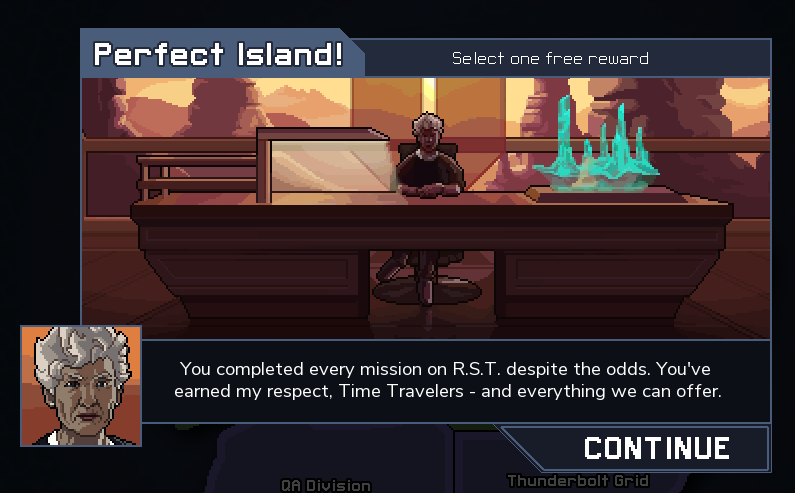
Prime Vek do not look any bigger than any other; they just look like they are pink or orange. They often appear as bosses and they are practically objectives unto themselves (that is, the player is given the objective of eliminating them). Gameplay-wise, Prime Vek are more powerful versions of Alpha Veks, and they have the advantage of being too big to drown in water.
PSIONS:
The Psions stand out amongst the Vek. Where most of the Veks appear to be giant bugs, the Psions appear to be Lovecraftian in appearance. (Indeed, they can be speculated to be the true masterminds behind the Vek incursions, especially after the player has reached the island that is the home of the Vek.)
They do not make attacks of their own. Instead, their presence grants advantageous bonuses to the Vek as long as they are on the battlefield. They will, however, float around to occupy locations that the CPU enemy deems to be advantageous to the player. (At other times though, they just seem to move around randomly.)
SPECIAL VEK:
There are some scenarios in which the player has to deal with special variants of Vek. One of these scenarios involve a volatile Vek, which the player has to keep alive instead of killing, no thanks to its biologically explosive volatility.
UNIQUE VEK:
Next, there are unique Vek that have no variants whatsoever. In fact, they do not even look insectoid. One of these is practically a colossal glob of slime; it attacks by simply consuming whatever it moves onto, and splits into smaller globs when it dies. Another unique Vek is a grub-like thing that tosses cocoons that hatch spiders.
It can seem a bit much for players to learn how to beat them, especially considering that these unique Vek only appear as end-of-island bosses. Fortunately, each and every one of their traits are documented in-game, complete with animated tooltips that show what they can do.
TURN ORDER:
When a turn ends, the Vek and any environmental hazard get to make their moves. However, they do not happen simultaneously.
Environmental hazards usually get to go first. This means that it is in the player’s interest to shift enemies into the area-of-effect of hazards.
The Vek themselves have varying turn orders, which are usually determined by their levels of power. For example, the Alpha or Prime Vek almost always go first.
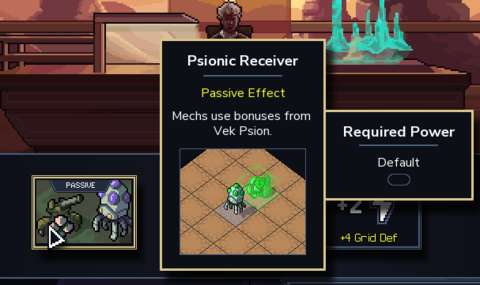
It is in the player’s interest to exploit the turn orders as much as possible, especially when trying to get the Vek to harm each other. However, the game will not provide the player with any visual indicators for the chain of attacks that the Vek would make.
VISUAL DESIGNS:
With the debut of this game, Subset Games has demonstrated that it does not care much for graphical designs beyond what are serviceable. Into The Breach is even less animated and less colourful than Faster Than Light.
Every sprite has just a handful of animations; some for idle animations, and some for death animations. Even their attack animations are little more than their sprites shifting around, albeit accompanied by additional effects such as white arcs that represent attacks. Moreover, the battlefield is only ever represented by 64 tiles and whatever sprites that are on top of them; the rest of the screen that is not the user interface is just black abyss.
The Mechs do not look much better either. They are just smudgy sprites, like the Vek. On the other hand, the Vek do get portraits of their own, while the Mechs do not.
Of course, such simple graphics also mean that the game loads very quickly, and noticeably faster than Faster Than Light does. Yet, there had been many indie games with far better pixel art, such that Into The Breach just looks lackadaisical in comparison.
At least the artwork for the character portraits look quite good, and they are animated. The portraits for the android characters are particularly cool-looking.
SOUND DESIGNS:
There is more variety in the sound designs than there are in visual designs. For example, every weapon has its own sound clip, even for weapons that are similar such as the cannons that Brute Mechs use.
The music is perhaps the most notable of the sound designs. It is composed by the same composer as that in Faster Than Light, Ben Prunty, and like the music in Subset’s previous game, it is composed of electronic tracks and flourishes. The latter are particularly more prevalent in this game than FTL; victories are made all the sweeter with these, compared to the dull swapping of tracks in FTL when the player wins a battle.
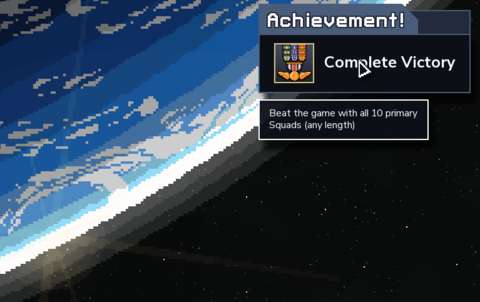
CONCLUSION:
There are actually not a lot of gameplay elements in Into The Breach; even Faster Than Light has more things that the player should keep in mind when playing that game. Yet, the gameplay elements of Into The Breach come together to form a game that is as much turn-based tactics as it is puzzle-solving; this makes for an incredibly refreshing experience (and this is coming from me, who is very jaded). Most importantly, its lack of egregiously fickle RNG rolls would serve as the newest high bar for the sophistication of turn-based tactical games.
